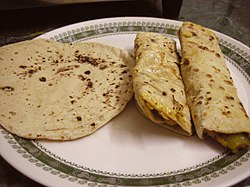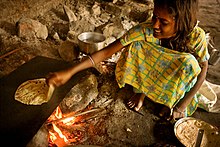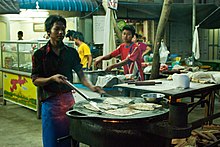Chapati: Difference between revisions
| Line 52: | Line 52: | ||
[[File:Chapati 2.jpg|thumb|right|Roti or chapati is consumed in India, Pakistan, Nepal, Sri Lanka and Bangladesh.]] |
[[File:Chapati 2.jpg|thumb|right|Roti or chapati is consumed in India, Pakistan, Nepal, Sri Lanka and Bangladesh.]] |
||
Chapatis are made using a soft dough comprising [[flour]] ([[whole grain]] [[common wheat]]), '[[Atta flour|Atta]]' in [[Hindi]]/[[Urdu]]/[[Punjabi language|Punjabi]]/[[Nepali language|Nepali]]/[[Bengali language|Bengali]], and [[water]]. Atta |
Chapatis are made using a soft dough comprising [[flour]] ([[whole grain]] [[common wheat]]), '[[Atta flour|Atta]]' in [[Hindi]]/[[Urdu]]/[[Punjabi language|Punjabi]]/[[Nepali language|Nepali]]/[[Bengali language|Bengali]], and [[water]]. Atta is made from hard Gehun (Indian wheat, or durum.<ref>[http://www.indiacurry.com/bread/br001aboutwheat.htm India Curry.com ''About Wheat''] </ref> It is more finely ground than most western-style whole wheat flours and, unlike western-style wholewheat flours, does not include bran.<ref>[http://www.answers.com/Q/What_is_the_difference_between_wheat_and_atta_flour What is the difference between wheat and atta flour? (answers.com)] </ref> |
||
Traditionally, roti (and rice) are made without salt to provide a bland background for spicy dishes.<ref> [http://werecipes.com/phulka-roti-recipe-homemade-chappati Phulka Roti Recipe, How To Make Phulka Chappati At Home April 26, 2015 by Gopi Patel] Under the heading ''A few tips for beginners'', no 10 is: ''This is Gujarati phulka roti recipe where I have not added salt. However you can add salt and season your dough while kneading dough for phulka roti.'' </ref> This also corresponds to modern dietary recommendations not to increase salt intake more than necessary.<ref>[http://www.fda.gov/ForConsumers/ConsumerUpdates/ucm181577.htm FDA Food and Drug Administration ''Lowering the Salt in Your Diet''] </ref> Some families also omit oil (that helps to make the finished product softer). |
Traditionally, roti (and rice) are made without salt to provide a bland background for spicy dishes.<ref> [http://werecipes.com/phulka-roti-recipe-homemade-chappati Phulka Roti Recipe, How To Make Phulka Chappati At Home April 26, 2015 by Gopi Patel] Under the heading ''A few tips for beginners'', no 10 is: ''This is Gujarati phulka roti recipe where I have not added salt. However you can add salt and season your dough while kneading dough for phulka roti.'' </ref> This also corresponds to modern dietary recommendations not to increase salt intake more than necessary.<ref>[http://www.fda.gov/ForConsumers/ConsumerUpdates/ucm181577.htm FDA Food and Drug Administration ''Lowering the Salt in Your Diet''] </ref> Some families also omit oil (that helps to make the finished product softer). |
||
Revision as of 15:20, 20 July 2015
This article needs additional citations for verification. (August 2008) |
 Plain chapati and stuffed rolled chapatis | |
| Alternative names | Roti/Poli |
|---|---|
| Type | [india]] |
| Place of origin | India |
| Region or state | South Asia, Central Asia, Horn of Africa, East Africa |
| Main ingredients | Flour |
Chapati (alternately Chapatti, Chappati or Chapathi) is an unleavened flatbread (also known as roti) from Sri Lanka, India, Nepal, Bangladesh and Pakistan.[1] It is a common staple in South Asia as well as amongst South Asian expatriates throughout the world. Versions of the dish are also found in Central Asia and the Horn of Africa, with the laobing flatbread serving as a local variation in China. Chapati is known as sapati or doday in the Pashto language.
History
The word 'Chapati' means "flattened round" in Indian languages [citation needed]. Chapati is noted in Ain-i-Akbari, a 16th-century document, by Mughal Emperor, Akbar’s vizier, Abu'l-Fazl ibn Mubarak.[1]
Chapatis are one of the most common forms in which wheat, the staple of northern and western India, is consumed. Chapati is a form of roti or rotta (bread). The words are often used interchangeably. Chapati or roti is made of whole wheat flour and cooked on a tava (flat skillet).
Cooking
| Nutritional value per 100 g (3.5 oz) | |||||||||||||||||||||||||||||||||||||||||||||
|---|---|---|---|---|---|---|---|---|---|---|---|---|---|---|---|---|---|---|---|---|---|---|---|---|---|---|---|---|---|---|---|---|---|---|---|---|---|---|---|---|---|---|---|---|---|
46.36 g | |||||||||||||||||||||||||||||||||||||||||||||
| Sugars | 2.72 | ||||||||||||||||||||||||||||||||||||||||||||
| Dietary fiber | 4.9 g | ||||||||||||||||||||||||||||||||||||||||||||
7.45 g | |||||||||||||||||||||||||||||||||||||||||||||
11.25 g | |||||||||||||||||||||||||||||||||||||||||||||
| |||||||||||||||||||||||||||||||||||||||||||||
| †Percentages estimated using US recommendations for adults,[2] except for potassium, which is estimated based on expert recommendation from the National Academies.[3] | |||||||||||||||||||||||||||||||||||||||||||||

Chapatis are made using a soft dough comprising flour (whole grain common wheat), 'Atta' in Hindi/Urdu/Punjabi/Nepali/Bengali, and water. Atta is made from hard Gehun (Indian wheat, or durum.[4] It is more finely ground than most western-style whole wheat flours and, unlike western-style wholewheat flours, does not include bran.[5] Traditionally, roti (and rice) are made without salt to provide a bland background for spicy dishes.[6] This also corresponds to modern dietary recommendations not to increase salt intake more than necessary.[7] Some families also omit oil (that helps to make the finished product softer).
A dough is prepared with flour and water, kneaded with the knuckles of the hand made into a fist and left to prove for thirty minutes (sometimes as long as an hour) for the gluten in the dough to develop. After proving, the dough becomes softer and more pliable.
Small portions of the dough are pinched off and formed into round balls that are pressed between the two palms to form discs which are then dipped into flour and rolled out on a circular dough rolling board (chakla) using a rolling pin (velan or belan) into a perfect circle. The belan is formed differently according to region, Gujaratis favouring a thin style that bulges in the middle. Beginners will only manage to achieve something that looks like a pair of underpants or a map of Australia.
The rolled-out dough is then thrown on the preheated dry tava (griddle) and cooked on both sides. In some regions of Nepal and western India they are only partly cooked on the skillet, and then put directly on a high flame, which makes them blow up like a balloon. The hot air cooks the chapati rapidly from the inside. In some parts of northern India (e.g. Punjab) and Pakistan, this is called a phulka (that which has been inflated). It is also possible to puff up the roti directly on the tava.[8] [9] Some families make roti in two styles using the phulka as accompaniment for certain dishes and a thicker style for others.
In Konkan, chapati is also called poli. Poli is slightly thicker than phulka and contains four layers and oil or pure ghee is applied after cooking. The poli will remain soft throughout the day.
During festivals, a sweet poli with stuffing, made with gram flour (besan) and sugar or jaggery, is prepared, called 'PuranPoli'. During Sankranti, a thin sweet poli stuffed with jaggery called 'Gud Poli' is prepared.

Often, the top of a chapati is slathered with butter or ghee (clarified butter). A piece of chapati is torn off and used to pick up the meat or vegetable dish(es) that make the meal.

Chapati sizes (diameter and thickness) vary from region to region and kitchen to kitchen. In Gujarat, for example, the chapati is called a 'rotli' and can be as thin as tissue paper. Chapatis made in domestic kitchens are usually not larger than 6–7 inches in diameter since the 'tava' on which they are made comes in sizes that fit comfortably on a domestic stove top. Tavas were traditionally made of unglazed earthenware, but are now typically made from metal. There are also electric tavas manufactured in Nepal and India. The shape of the rolling pin also varies from region to region. Some households simply use a kitchen work top as a sort of pastry board, but homes have round flat-topped 'boards' that may be made of wood or stone and nowadays even stainless steel, specifically for rolling out chapatis.
Flat unleavened breads in South Asia come in many forms; the chapati is only one of them. A rotta, made of a dough similar to that used to make chapatis and cooked in an oven, is a 'tandoori roti'. The combination of wheat flour with one or more flours (e.g. chickpea, maize, or millet) will produce a "missi roti". Rottas made with pearl millet (Bajra) or Maize (makka) or Jowar flour usually carry the name of the flour, as in "bajra roti" or "makke ki roti" (or "bhakri" in Marathi). Flat breads such as chapati and roti are traditionally a food of northern South Asia. The peninsular south, the east and northeast and Kashmir are primarily rice-eating cultures.

In most parts of India, there is a distinction made between a 'chapati' and its layered version, the 'paratha'. 'Parathas' are either made layered by spreading with ghee or oil folding and rolling out again into a disc, or else have a filling, such as spinach, dal (lentils) cooked radish, or potato. Parathas are mostly made using all-purpose flour instead of whole wheat flour. There is a newer version called 'Tandoori Roti' which is thick like the Paratha- and made using whole wheat flour.
There are many modern varieties of chapati in India.
- Paneer chapati: Grated Paneer is added to the usual chapati dough
- Radish or Mullangi chapati: Grated radish and turmeric powder is added to the dough and the chapati is usually thick. It is often eaten by lorry drivers who eat in roadside dhabas during their long journey to some other state.
- Vegetable stuffed chapati: In this type of chapati, a gravy of carrot, potato, peas, fenugreek are mashed and slightly sauted into a masala gravy. It is usually given rolled and many households prepare this using their own variety and combinations of available vegetables.
In the Maldives, chapati are traditionally eaten for breakfast along with a dish known as mas huni.[10]
See also
References
- ^ a b Of Bread Ain-i-Akbari , by Abu'l-Fazl ibn Mubarak. English tr. by Heinrich Blochmann and Colonel Henry Sullivan Jarrett, 1873–1907. The Asiatic Society of Bengal, Calcutta, Volume I, Chap. 26, page 61.
- ^ United States Food and Drug Administration (2024). "Daily Value on the Nutrition and Supplement Facts Labels". FDA. Archived from the original on 2024-03-27. Retrieved 2024-03-28.
- ^ National Academies of Sciences, Engineering, and Medicine; Health and Medicine Division; Food and Nutrition Board; Committee to Review the Dietary Reference Intakes for Sodium and Potassium (2019). Oria, Maria; Harrison, Meghan; Stallings, Virginia A. (eds.). Dietary Reference Intakes for Sodium and Potassium. The National Academies Collection: Reports funded by National Institutes of Health. Washington, DC: National Academies Press (US). ISBN 978-0-309-48834-1. PMID 30844154. Archived from the original on 2024-05-09. Retrieved 2024-06-21.
- ^ India Curry.com About Wheat
- ^ What is the difference between wheat and atta flour? (answers.com)
- ^ Phulka Roti Recipe, How To Make Phulka Chappati At Home April 26, 2015 by Gopi Patel Under the heading A few tips for beginners, no 10 is: This is Gujarati phulka roti recipe where I have not added salt. However you can add salt and season your dough while kneading dough for phulka roti.
- ^ FDA Food and Drug Administration Lowering the Salt in Your Diet
- ^ Soft Roti/Fulka/Chapati Recipe With And Without Gas Flame | Puff Roti in a skillet/tawa CookingShooking
- ^ Phulka Roti Recipe, How To Make Phulka Chappati At Home April 26, 2015 by Gopi Patel
- ^ Xavier Romero-Frias, The Maldive Islanders, A Study of the Popular Culture of an Ancient Ocean Kingdom, Barcelona 1999, ISBN 84-7254-801-5





